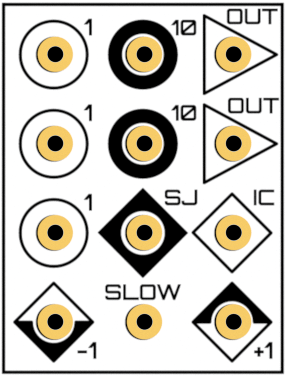Difference between revisions of "Integrator"
(Some basic text, quite similar to Summer.) |
|||
| Line 21: | Line 21: | ||
{{todo|write this section}} | {{todo|write this section}} | ||
| + | |||
| + | [[Category:Components of The Analog Thing]] | ||
Revision as of 22:48, 23 July 2021
An Integrator is an elementary building block of an analog computer which carries out an Integration in time, as in c = integral_0^t integrand(t') dt'. The Analog Thing ships five integrators. That menas you can compute five integrals in a circuit.
Integration in analog computing typically falls back on continously charging a capacity (condensator). The only difference between an integrator and a summer is this very capacity in the feedback channel instead of a simple resistance. Therefore, all integrators are also summing their inputs. For more details, please refer to Analog computing literature.
Basic Usage of an Integrator on The Analog Thing
- Circles represent inputs, triangles outputs
- Analog integrators always sum their inputs. That is, if you have a sum under your integral, you can save a single summer before the integrator. Otherwise, just put your integrand into the upper left input labeled with
1. - There are two output slots. Just use one of them as you like.
- The
ICslot stands for initial conditions. It is an input where you have to provide suitable initial conditions. As shorthands,-1and+1are right to the hand. If this slot is left empty,0is taken as initial condition. - For the time being, ignore the slots
SJandSLOW.
![]() Attention: Make sure the sum of your inputs does not exceed logical 1 (10V), otherwise an Overflow happens and the overflow LED will shine
Attention: Make sure the sum of your inputs does not exceed logical 1 (10V), otherwise an Overflow happens and the overflow LED will shine ![]() . See Logic levels for details.
. See Logic levels for details.
